Typology-Specific Gaps in Building Fire Safety: A Scientometric Review of Technologies, Functions, and Research Trends
Abstract
1. Introduction
1.1. Previous Studies
- Vertical evacuation strategies in high-rise buildings;
- Fire resilience of heritage and cultural sites;
- Fire safety in sustainable and green buildings;
1.2. Research Objectives and Questions
- To map the evolution and scope of fire safety research, including trends in publication year, document types, author networks, contributing countries, and source journals.
- To classify and evaluate the methodological and technological tools, including simulation platforms, BIM-integrated systems, risk assessment models, and AI-based applications, used in fire safety design and analysis.
- To identify critical research gaps and typology-function mismatches, particularly in areas like healthcare facilities, post-earthquake fire scenarios, and sustainability-linked planning.
- To develop a conceptual matrix that links building functions with fire safety technologies and implementation patterns, aiming to support future research and context-specific safety strategies.
- Q1: How have “the research dynamics of fire safety in buildings” evolved in terms of publication years, types, authorship, contributing countries, and source journals?
- Q2: How effective and comprehensive are fire safety measures when assessed across different building functions?
- Q3: What methodological approaches are employed in fire safety management and risk assessment, and how do they align with typology-specific needs?
- Q4: Which technologies are applied in fire safety systems, and what is their functional distribution across typologies?
- Q5: How can pre-fire planning, emergency response, and post-fire recovery processes be enhanced in context-sensitive ways?
- Q6: What knowledge gaps exist in current fire safety literature, and how can future studies address these gaps through integrated and performance-based approaches?
2. Materials and Methods
2.1. Research Design
2.2. Database Selection and Search Strategy
2.3. Inclusion and Exclusion Criteria
- (i)
- peer-reviewed journal articles;
- (ii)
- published in English between 2010 and 2025;
- (iii)
- directly addressing fire safety in buildings;
- (iv)
- focused on risk analysis, simulation tools, or functional safety components.
2.4. Data Extraction and Analysis Process
- (a)
- (b)
- Typology-Function-Tool Cross-Tabulation: Each article was manually coded to determine which fire safety components were addressed, and how those aligned with specific building types (residential, commercial, high-rise, healthcare, heritage, etc.). This enabled the construction of matrices and figures linking building function with safety system coverage.
3. Results
3.1. Bibliometric Analysis
3.2. Keyword Analysis
3.3. Building Typologies in Fire Safety Research
3.4. Tools and Technological Classifications in Building Fire Safety Research
4. Discussion
4.1. Dominance of Engineering and Simulation-Focused Paradigms
4.2. Typological Asymmetry and Functional Neglect
4.3. Fragmentation in Technological Integration
4.4. Scientometric Shifts and Conceptual Transitions
4.5. Toward Typology-Specific and Context-Sensitive Frameworks
5. Conclusions
- Research in fire safety remains heavily concentrated on evacuation modeling, particularly in high-rise and general-purpose buildings. In contrast, detection and suppression systems are significantly less examined, indicating a limited functional scope in much of the literature.
- Typological representation in existing studies is uneven. Vulnerable building types such as healthcare facilities, heritage structures, and informal settlements are notably underrepresented, despite their complex fire risk profiles and operational constraints.
- Technological tools such as BIM, simulation platforms, and AI-based systems are increasingly applied, yet their implementation is often fragmented and lacks integration across safety functions. Interoperability and real-time responsiveness remain largely absent.
Funding
Institutional Review Board Statement
Informed Consent Statement
Data Availability Statement
Conflicts of Interest
Abbreviations
| AHP | Analytic Hierarchy Process |
| AI | Artificial Intelligence |
| BIM | Building Information Modelling |
| CFD | Computational Fluid Dynamics |
| CEPI | Scalar Calculation of Fire Hazard |
| CFO | Consequence-Oriented Fire Intensity Optimization |
| FDS | Fire Dynamics Simulator |
| FAHP | Fuzzy Analytic Hierarchy Process |
| FMEA | Failure Modes and Effects Analysis |
| GIS | Geographic Information System |
| HVAC | Heating, Ventilation, and Air Conditioning |
| IoT | Internet of Things |
| MCDM | Multi Criteria Decision Making |
| PRISMA | Preferred Reporting Items for Systematic Reviews and Meta-Analyses |
| PyroSim | Graphical User Interface for FDS |
| SLR | Systematic Literature Review |
| VR | Virtual Reality |
| WoS | Web of Science |
References
- Masoumi, Z.; van L.Genderen, J.; Maleki, J. Fire Risk Assessment in Dense Urban Areas Using Information Fusion Techniques. ISPRS Int. J. Geo-Inf. 2019, 8, 579. [Google Scholar] [CrossRef]
- Mi, H.; Liu, Y.; Jiao, Z.; Wang, W.; Wang, Q. A numerical study on the optimization of ventilation mode during emergency of cable fire in utility tunnel. Tunn. Undergr. Space Technol. 2020, 100, 103403. [Google Scholar] [CrossRef]
- Bacciu, V.; Sirca, C.; Spano, D. Towards a systemic approach to fire risk management. Environ. Sci. Policy 2022, 129, 37–44. [Google Scholar] [CrossRef]
- Mell, W.; Simeoni, A.; Morvan, D.; Hiers, J.K.; Skowronski, N.; Hadden, R.M. Clarifying the meaning of mantras in wildland fire behaviour modelling: Reply to Cruz et al. (2017). Int. J. Wildland Fire 2018, 27, 770–775. [Google Scholar] [CrossRef]
- Kürüm Varolgüneş, F.; Varolgüneş, S. Post-Earthquake Fires (PEFs) in the Built Environment: A Systematic and Thematic Review of Structural Risk, Urban Impact, and Resilience Strategies. Fire 2025, 8, 233. [Google Scholar] [CrossRef]
- Rani, G.; Siddiqui, N.A.; Yadav, M.; Ansari, S. Hierarchical integrated spatial risk assessment model of fire hazard for the core city areas in India. Land Use Policy 2023, 126, 106536. [Google Scholar] [CrossRef]
- Thorp, T.N.; Fischer, E.C.; Sinha, A. A Delphi study to identify and prioritize research gaps for the incorporation of a fire into life cycle assessment of structures. Fire Saf. J. 2022, 129, 103571. [Google Scholar] [CrossRef]
- Chow, W.K. Fire Safety Technology Related to Building Design and Construction. Int. J. Integr. Eng. 2012, 4, 22–26. [Google Scholar]
- Garcia-Castillo, E.; Paya-Zaforteza, I.; Hospitaler, A. Fire in heritage and historic buildings, a major challenge for the 21st century. Dev. Built Environ. 2023, 13, 100102. [Google Scholar] [CrossRef]
- Minervino, B.d.L.F.; Calmeiro, C.C.; Von Kruguer, P.G.; Rodrigues, J.P.C. Fire Risk Analysis: A Proposal for Historic Buildings in Brazil. Int. J. Archit. Herit. 2025, 19, 542–550. [Google Scholar] [CrossRef]
- Meacham, B.J. A Sociotechnical Systems Framework for Performance-Based Design for Fire Safety. Fire Technol. 2022, 58, 1137–1167. Available online: https://link.springer.com/article/10.1007/s10694-022-01219-0 (accessed on 28 October 2025). [CrossRef]
- Chow, W.K. Performance-based approach to determining fire safety provisions for buildings in the Asia-Oceania regions. Build. Environ. 2015, 91, 127–137. [Google Scholar] [CrossRef]
- van Eck, N.J.; Waltman, L. Software survey: VOSviewer, a computer program for bibliometric mapping. Scientometrics 2010, 84, 523–538. [Google Scholar] [CrossRef]
- Aria, M.; Cuccurullo, C. bibliometrix: An R-tool for comprehensive science mapping analysis. J. Informetr. 2017, 11, 959–975. [Google Scholar] [CrossRef]
- Zhu, G.; Zhang, G.; Yuan, G.; Li, Q. Performance-Based Evaluation of Large Steel-Framed Structures in the Overall Fire Process. J. Appl. Math. 2014, 2014, 604936. [Google Scholar] [CrossRef]
- Khan, N.; Ali, A.K.; Tran, S.V.-T.; Lee, D.; Park, C. Visual Language-Aided Construction Fire Safety Planning Approach in Building Information Modeling. Appl. Sci. 2020, 10, 1704. [Google Scholar] [CrossRef]
- Chang, W.Y.; Tang, C.H.; Lin, C.Y. Estimation of Magnitude and Heat Release Rate of Fires Occurring in Historic Buildings-Taking Churches as an Example. Sustainability 2021, 13, 9193. [Google Scholar] [CrossRef]
- Deng, H.; Ou, Z.; Zhang, G.; Deng, Y.; Tian, M. BIM and Computer Vision-Based Framework for Fire Emergency Evacuation Considering Local Safety Performance. Sensors 2021, 21, 3851. [Google Scholar] [CrossRef]
- Franchini, A.; Galasso, C.; Torero, J.L. Probabilistic Performance-based Fire Design of Structures: A Hazard-Centred and Consequence-Oriented Perspective. Fire Technol. 2024, 60, 2845–2873. [Google Scholar] [CrossRef]
- Liao, C.; Yang, J.; Li, X.; Qiu, Z.; Li, K.; Li, T. Study on temperature distribution and smoke diffusion characteristics of cable shafts in high-rise buildings. Case Stud. Therm. Eng. 2023, 49, 103324. [Google Scholar] [CrossRef]
- Yang, X.; Wu, S.; Xu, S.; Chen, B.; Chen, D.; Wang, F.; Jiang, J.; Fan, L.; Tu, L. Effects of GBFS content and curing methods on the working performance and microstructure of ternary geopolymers based on high-content steel slag. Constr. Build. Mater. 2024, 410, 134128. [Google Scholar] [CrossRef]
- Sun, Q.; Turkan, Y. A BIM-based simulation framework for fire safety management and investigation of the critical factors affecting human evacuation performance. Adv. Eng. Inform. 2020, 44, 101093. [Google Scholar] [CrossRef]
- Zhang, L.; Wang, W.; Lou, T.; Hou, H. Post-earthquake fire performance of partially encased composite steel and concrete columns. J. Constr. Steel Res. 2024, 222, 108961. [Google Scholar] [CrossRef]
- Adhikari, P.; Mahmoud, H.; Xie, A.; Simonen, K.; Ellingwood, B. Life-cycle cost and carbon footprint analysis for light-framed residential buildings subjected to tornado hazard. J. Build. Eng. 2020, 32, 101657. [Google Scholar] [CrossRef]
- Said, M.S.M.; Tohir, M.Z.M. The effect of ultraviolet coating on containment and fire hazards of phase change materials impregnated wood structure. J. Energy Storage 2020, 32, 101727. [Google Scholar] [CrossRef]
- Wróblewski, W.; Tuśnio, N.; Wolny, P.; Siuta, D.; Trzebicki, J.; Bączkowska, T.; Dzikowska-Diduch, O.; Pruszczyk, P. Fire Safety of Healthcare Units in Conditions of Oxygen Therapy in COVID-19: Empirical Establishing of Effects of Elevated Oxygen Concentrations. Sustainability 2022, 14, 4315. [Google Scholar] [CrossRef]
- Li, X.; Qin, R. Performance-based firefighting in dense historic settlements: An exploration of a firefighting approach combining value and risk assessment with numerical simulation. Front. Archit. Res. 2022, 11, 1134–1150. [Google Scholar] [CrossRef]
- Maluk, C.; Woodrow, M.; Torero, J.L. The potential of integrating fire safety in modern building design. Fire Saf. J. 2017, 88, 104–112. [Google Scholar] [CrossRef]
- Cheng, H.; Liu, C.; Chen, J.; Wu, L.; Zhao, Y.; Zhong, M. Full-scale experimental study on fire under natural ventilation in the T-shaped and curved tunnel groups. Tunn. Undergr. Space Technol. 2022, 123, 104442. [Google Scholar] [CrossRef]
- Choi, M.; Chi, S. Optimal route selection model for fire evacuations based on hazard prediction data. Simul. Model. Pract. Theory 2019, 94, 321–333. [Google Scholar] [CrossRef]
- Papinigis, V.; Geda, E.; Lukošius, K. Design of people evacuation from rooms and buildings. J. Civ. Eng. Manag. 2010, 16, 131–139. [Google Scholar] [CrossRef]
- Khorasani, N.E.; Garlock, M.E.M. Overview of fire following earthquake: Historical events and community responses. Int. J. Disaster Resil. Built Environ. 2017, 8, 158–174. [Google Scholar] [CrossRef]
- Liu, T.; Li, A.; Yao, M.; Deng, J.; Huang, Q.; Li, Z.; Li, H.; Yi, X. Fire Behavior Characteristics and Computational Simulation Research on Historic Wooden Structures. Fire 2024, 7, 478. [Google Scholar] [CrossRef]
- Omidvari, M.; Mansouri, N.; Nouri, J. A pattern of fire risk assessment and emergency management in educational center laboratories. Saf. Sci. 2015, 73, 34–42. [Google Scholar] [CrossRef]
- Perera, U.D.S.; Kulatunga, U.; Abdeen, F.N.; Sepasgozar, S.M.E.; Tennakoon, M. Application of building information modelling for fire hazard management in high-rise buildings: An investigation in Sri Lanka. Intell. Build. Int. 2022, 14, 207–221. [Google Scholar] [CrossRef]
- Yang, Y.; Sun, Y.; Chen, M.; Zhou, Y.; Wang, R.; Liu, Z. Platform Development of BIM-Based Fire Safety Management System Considering the Construction Site. Buildings 2022, 12, 1268. [Google Scholar] [CrossRef]
- Choi, M.Y.; Jun, S. Fire Risk Assessment Models Using Statistical Machine Learning and Optimized Risk Indexing. Appl. Sci. 2020, 10, 4199. [Google Scholar] [CrossRef]
- Zhang, Y.; Wang, G.; Wang, X.; Kong, X.; Jia, H.; Zhao, J. Regional High-Rise Building Fire Risk Assessment Based on the Spatial Markov Chain Model and an Indicator System. Fire 2024, 7, 16. [Google Scholar] [CrossRef]
- Yan, Z.; Wang, Y.; Chao, L. Simulation study on fire and evacuation of super high-rise commercial building. Case Stud. Therm. Eng. 2023, 52, 103519. [Google Scholar] [CrossRef]
- Yahaya, I. Autonomous Safety Mechanism for Building: Fire Fighter Robot with Localized Fire Extinguisher. Int. J. Integr. Eng. 2020, 12, 304–314. Available online: https://penerbit.uthm.edu.my/ojs/index.php/ijie/article/view/5731/4551 (accessed on 28 October 2025).
- Ketsakorn, A.; Phangchandha, R. Application of Analytic Hierarchy Process to Rank Fire Safety Factors for Assessing the Fire Probabilistic Risk in School for the Blind Building: A Case Study in Thailand. Fire 2023, 6, 354. [Google Scholar] [CrossRef]
- Alisawi, A.T.; Collins, P.E.F.; Cashell, K.A. Nonlinear Analysis of a Steel Frame Structure Exposed to Post-Earthquake Fire. Fire 2021, 4, 73. [Google Scholar] [CrossRef]
- Cheung, W.K.; Zeng, Y.; Lin, S.; Huang, X. Modelling carbon monoxide transport and hazard from smoldering for building fire safety design analysis. Fire Saf. J. 2023, 140, 103895. [Google Scholar] [CrossRef]
- Maiworm, B.; Göldner, M.; Mannl, K.; Hammann, C. Evaluating 900 Potentially Harming Fires in Germany: Is the Prescriptive Building Code Effective? German Fire Departments Assessed Fire Safety Measures in Buildings Through On-Site Inspections. Fire Technol. 2024, 60, 2041–2065. [Google Scholar] [CrossRef]
- Cai, N.; Chow, W.K. Numerical studies on fire hazards of elevator evacuation in supertall buildings. Indoor Built Environ. 2019, 28, 247–263. [Google Scholar] [CrossRef]
- Salleh, N.; Salim Nuzaihan Aras, A.; Norazman, N.; Nizam Kamaruzzaman, S. Fire risk assessment of Malaysia public hospital buildings. J. Facil. Manag. 2023, 21, 635–650. [Google Scholar] [CrossRef]
- Yan, F.; Jia, J.; Hu, Y.; Guo, Q.; Zhu, H. Smart Fire Evacuation Service Based on Internet of Things Computing for Web3D. J. Internet Technol. 2019, 20, 521–532. [Google Scholar] [CrossRef]
- Yang, Y.; Xu, Z.; Wu, Y.; Wei, W.; Song, R. Virtual Fire Evacuation Drills through a Web-Based Serious Game. Appl. Sci. 2021, 11, 11284. [Google Scholar] [CrossRef]
- Zhang, L.; Wu, X.; Liu, M.; Liu, W.; Ashuri, B. Discovering worst fire scenarios in subway stations: A simulation approach. Autom. Constr. 2019, 99, 183–196. [Google Scholar] [CrossRef]
- Page, M.J.; E McKenzie, J.; Bossuyt, P.M.; Boutron, I.; Hoffmann, T.C.; Mulrow, C.D.; Shamseer, L.; Tetzlaff, J.M.; Moher, D. Updating guidance for reporting systematic reviews: Development of the PRISMA 2020 statement. J. Clin. Epidemiol. 2021, 134, 103–112. [Google Scholar] [CrossRef]
- Khan, K.S.; Kunz, R.; Kleijnen, J.; Antes, G. Five Steps to Conducting a Systematic Review. J. R. Soc. Med. 2003, 96, 118–121. [Google Scholar] [CrossRef] [PubMed]
- Moher, D.; Liberati, A.; Tetzlaff, J.; Altman, D.G. Preferred reporting items for systematic reviews and meta-analyses: The PRISMA statement. BMJ 2009, 339, 332–336. [Google Scholar] [CrossRef] [PubMed]
- Ralph, B.; Carvel, R.; Floyd, J. Coupled hybrid modelling within the Fire Dynamics Simulator: Transient transport and mass storage. J. Build. Perform. Simul. 2019, 12, 685–699. Available online: https://www.tandfonline.com/doi/full/10.1080/19401493.2019.1608304 (accessed on 28 October 2025). [CrossRef]
- Li, S.Y.; Tao, G.; Zhang, L.J. Fire Risk Assessment of High-rise Buildings Based on Gray-FAHP Mathematical Model. Procedia Eng. 2018, 211, 395–402. [Google Scholar] [CrossRef]
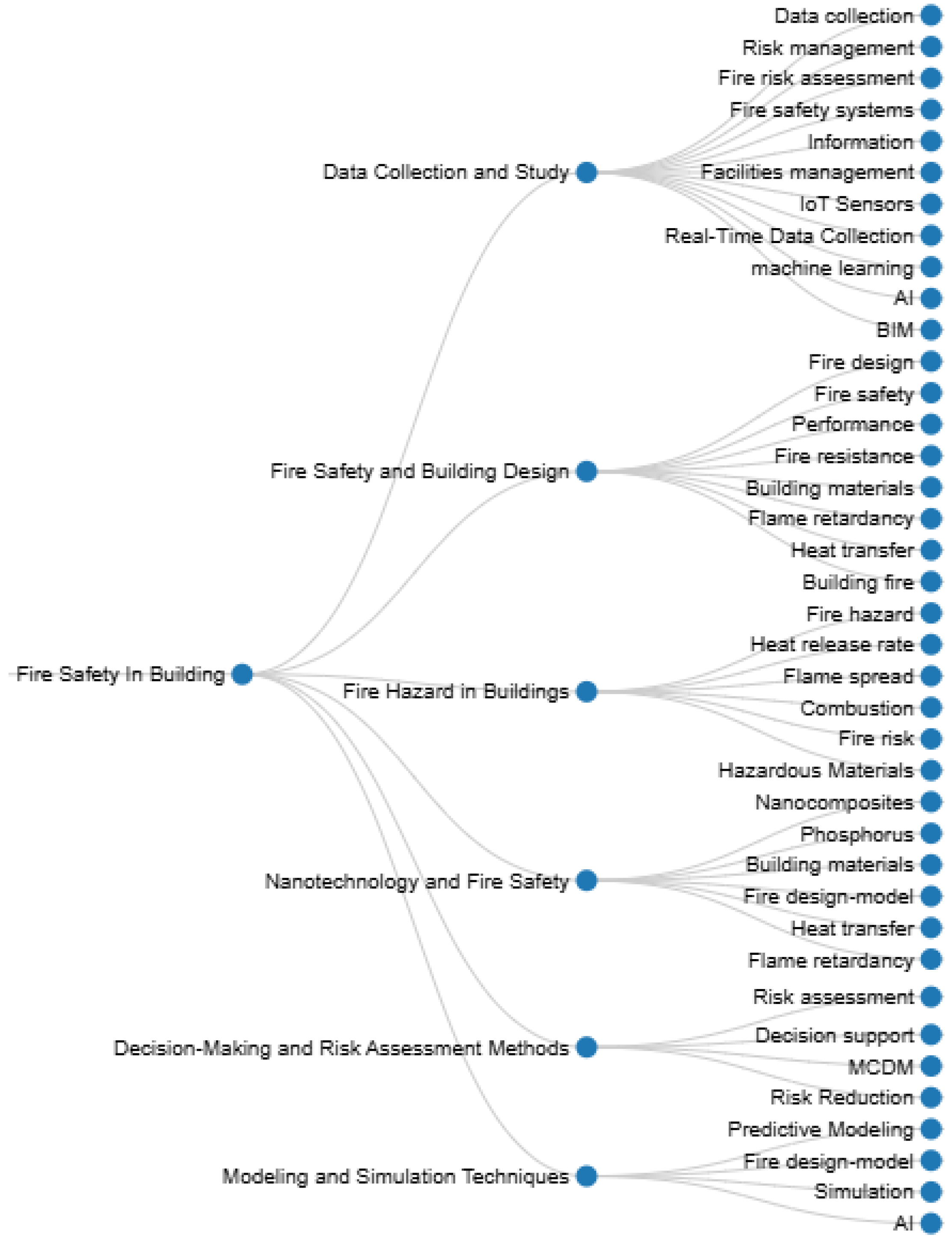
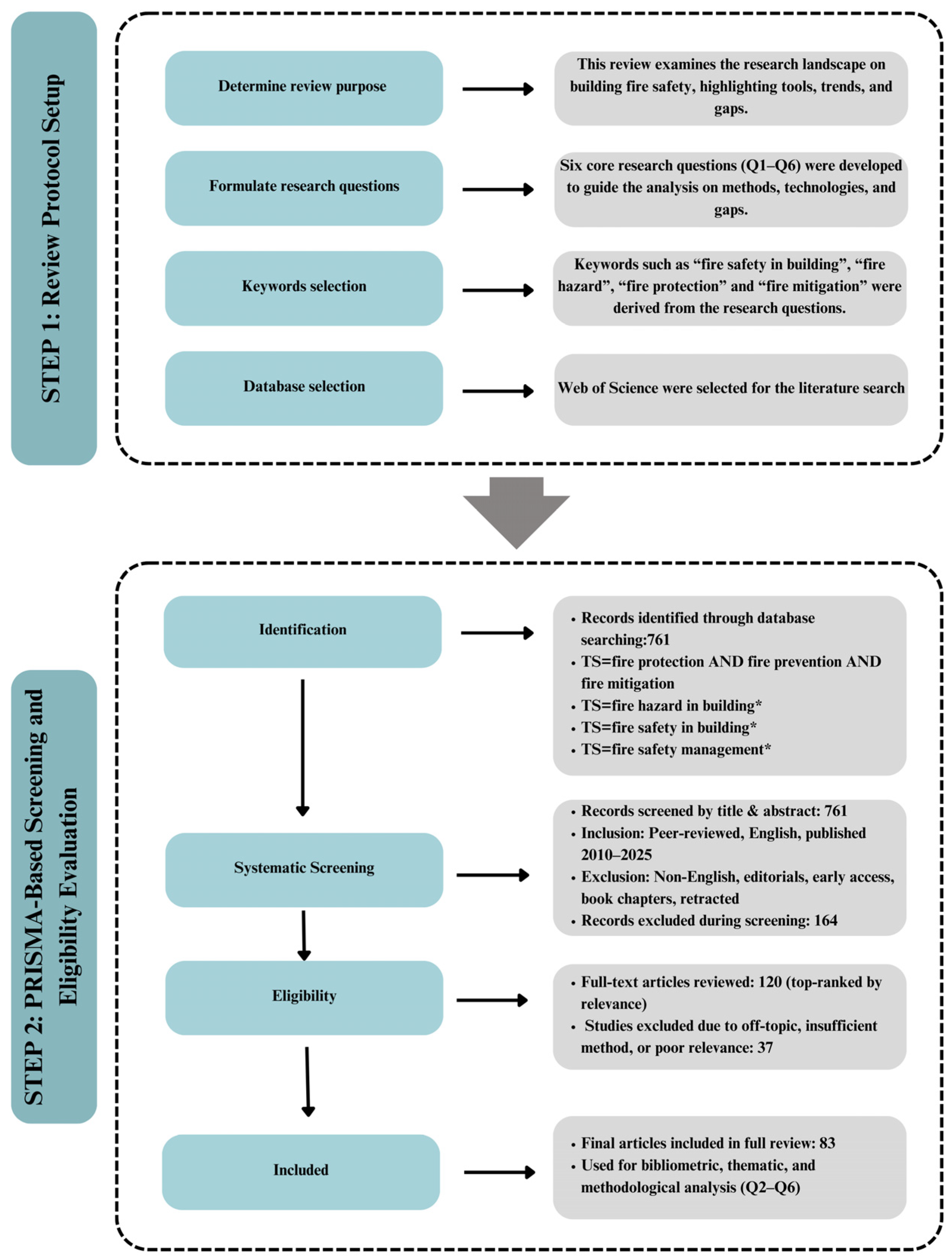
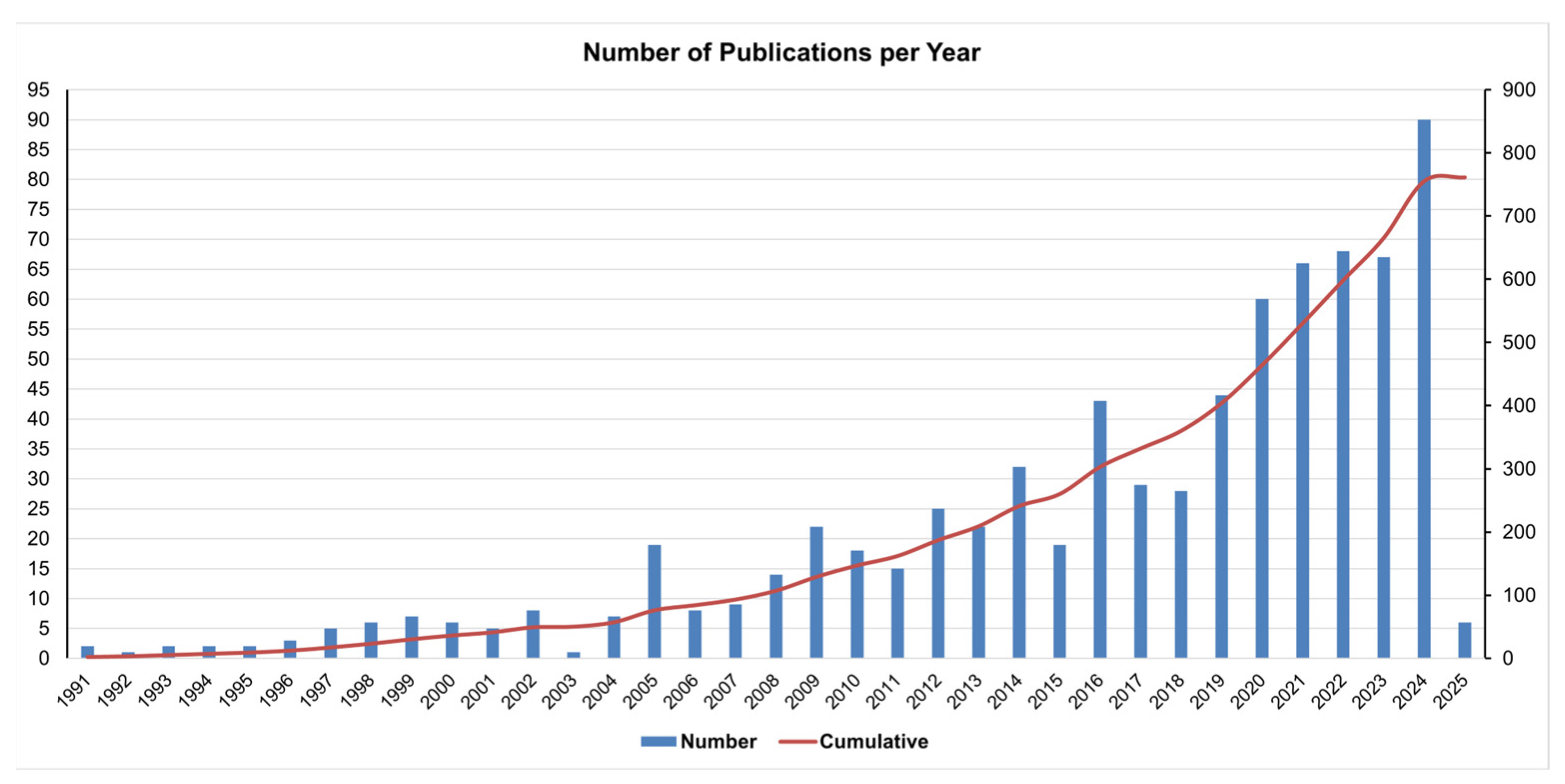



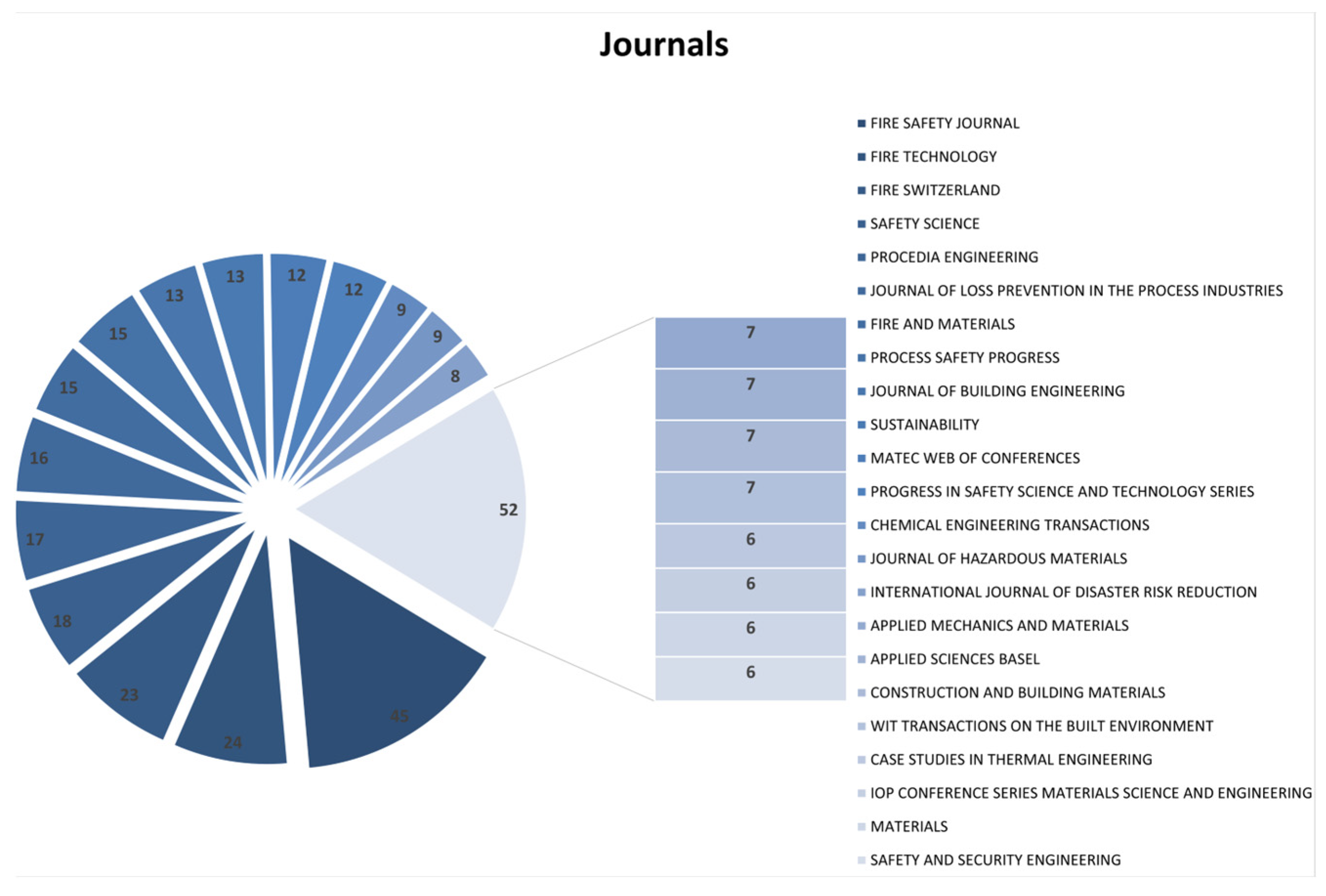

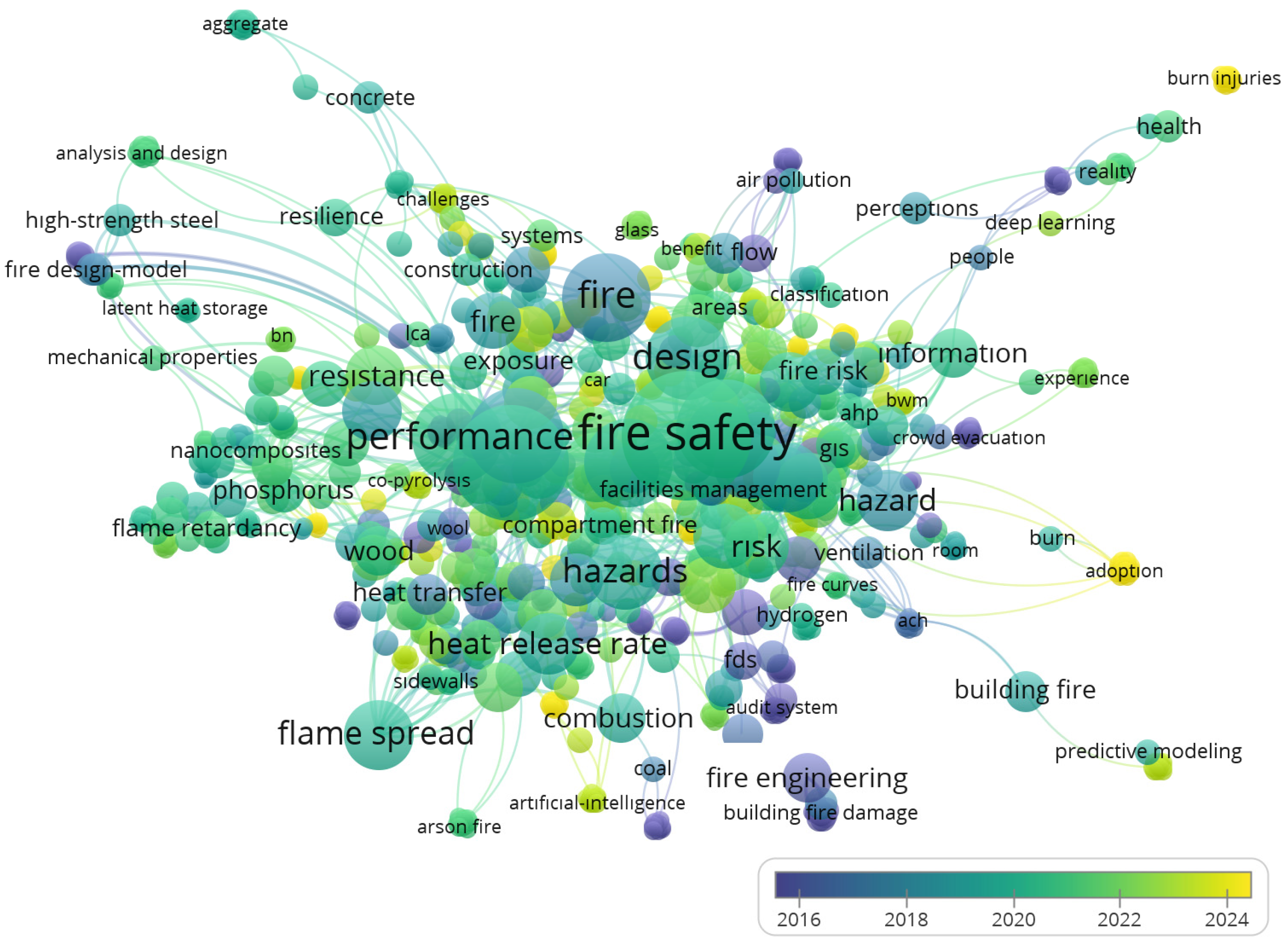
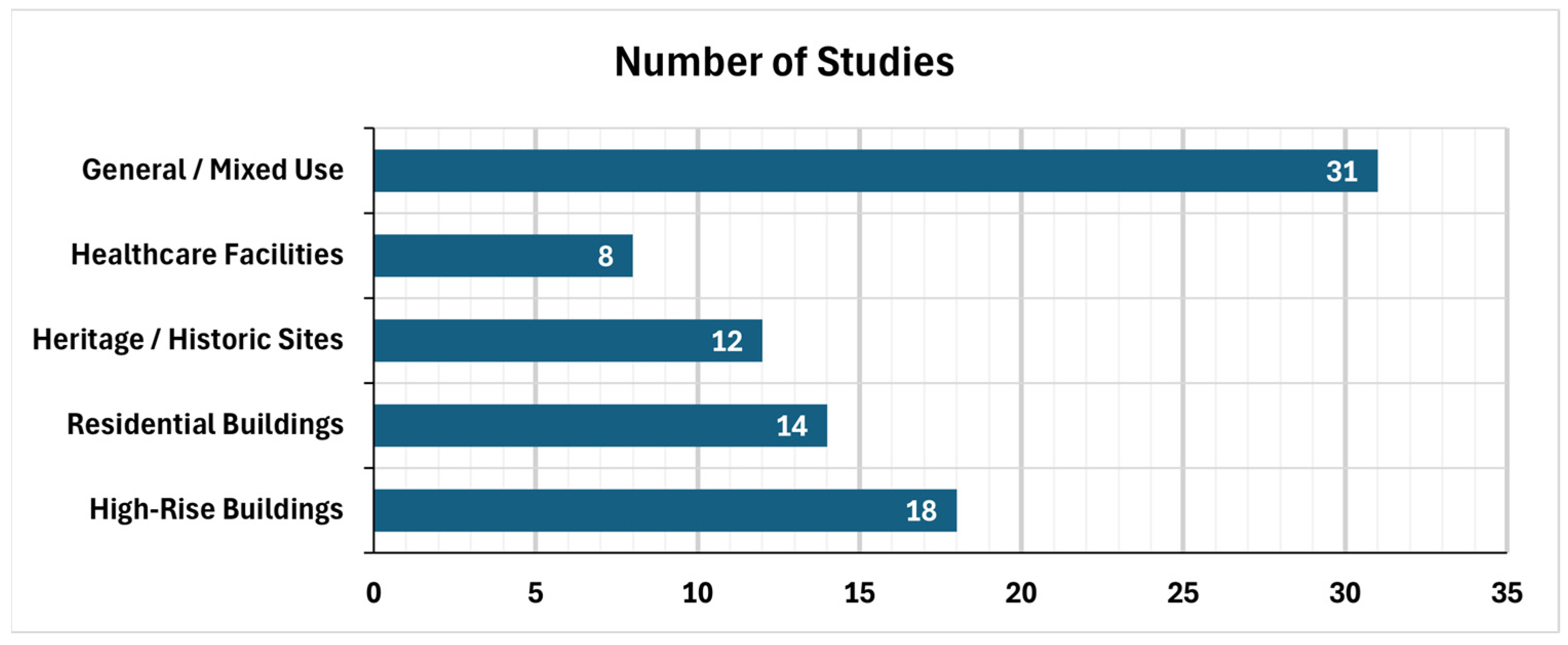



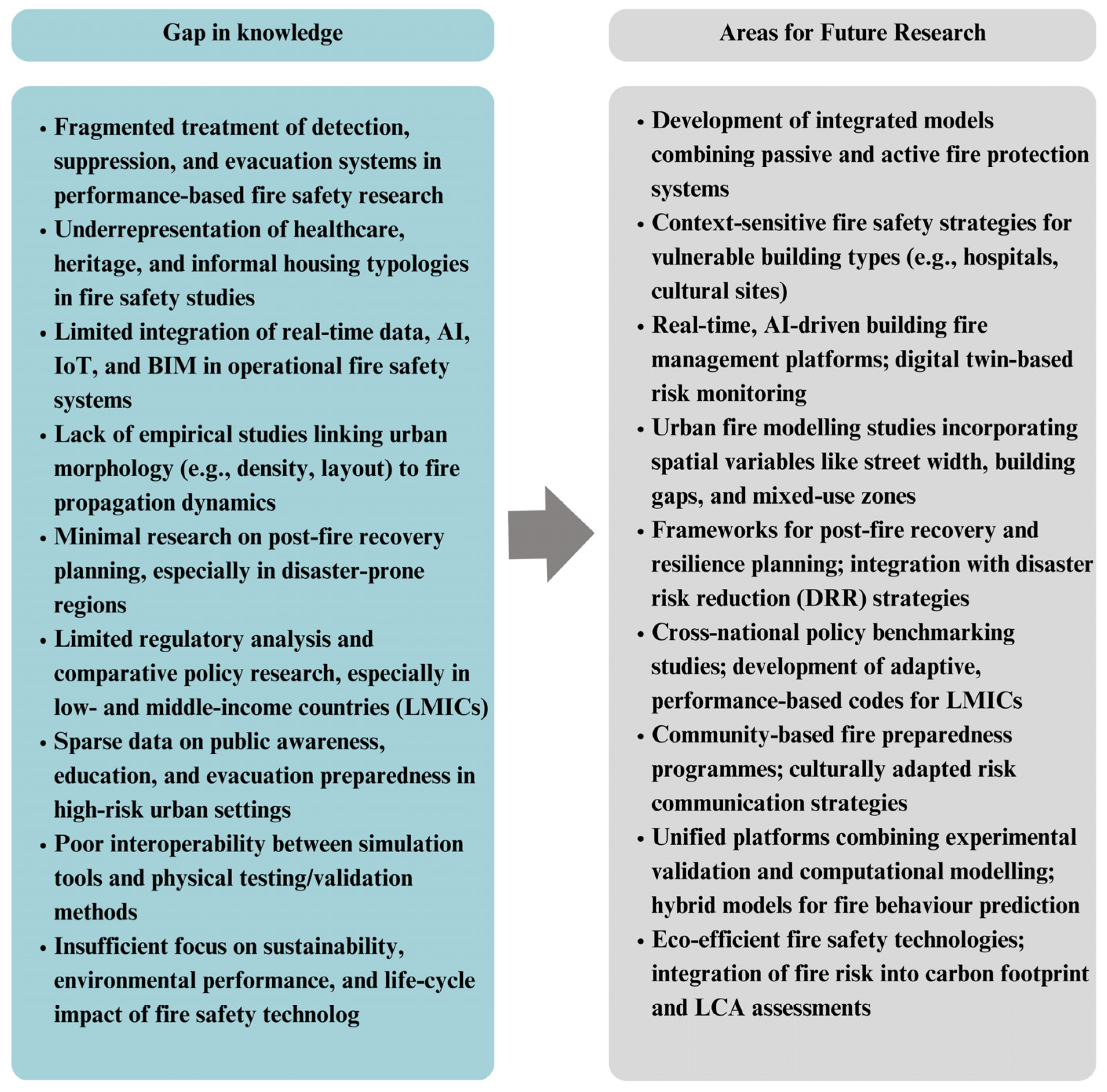
| Period | Thematic Focus | Key Concepts and Tools | References |
|---|---|---|---|
| 1990–2004 | Physical fire behavior, material response, flame propagation | Flame spread, combustion, fire load, heat release rate, structural collapse | [8,15,25,26,27,28,29] |
| 2005–2014 | Risk analysis, scenario modelling, performance-based systems, human behavior | Fire risk assessment, agent-based evacuation models, fire scenarios, CFD, PyroSim, Pathfinder | [9,11,16,30,31,32,33,34] |
| 2015–2019 | High-rise buildings, heritage buildings, BIM integration, green fire safety | BIM-FDS integration, neural network modelling, cultural heritage fire resilience | [10,18,19,20,22,35,36,37] |
| 2020–2025 | Sustainability, AI & IoT, multi-hazard resilience, digitalization in fire safety | Smart sensors, life-cycle cost, post-earthquake fire, VR evacuation drills, carbon footprint | [7,24,38,39,40,41,42,43] |
Disclaimer/Publisher’s Note: The statements, opinions and data contained in all publications are solely those of the individual author(s) and contributor(s) and not of MDPI and/or the editor(s). MDPI and/or the editor(s) disclaim responsibility for any injury to people or property resulting from any ideas, methods, instructions or products referred to in the content. |
© 2025 by the author. Licensee MDPI, Basel, Switzerland. This article is an open access article distributed under the terms and conditions of the Creative Commons Attribution (CC BY) license (https://creativecommons.org/licenses/by/4.0/).
Share and Cite
Kürüm Varolgüneş, F. Typology-Specific Gaps in Building Fire Safety: A Scientometric Review of Technologies, Functions, and Research Trends. Fire 2025, 8, 423. https://doi.org/10.3390/fire8110423
Kürüm Varolgüneş F. Typology-Specific Gaps in Building Fire Safety: A Scientometric Review of Technologies, Functions, and Research Trends. Fire. 2025; 8(11):423. https://doi.org/10.3390/fire8110423
Chicago/Turabian StyleKürüm Varolgüneş, Fatma. 2025. "Typology-Specific Gaps in Building Fire Safety: A Scientometric Review of Technologies, Functions, and Research Trends" Fire 8, no. 11: 423. https://doi.org/10.3390/fire8110423
APA StyleKürüm Varolgüneş, F. (2025). Typology-Specific Gaps in Building Fire Safety: A Scientometric Review of Technologies, Functions, and Research Trends. Fire, 8(11), 423. https://doi.org/10.3390/fire8110423





